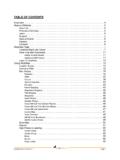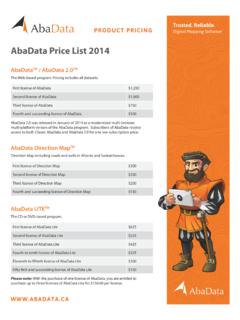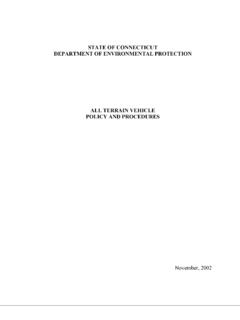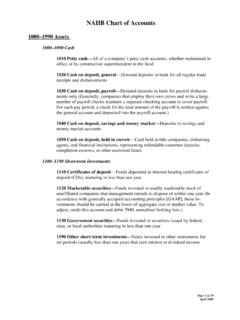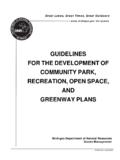Transcription of land inventory legend - Abacus Datagraphics
1 1 legend information for Canada land inventory AbaData datasets AGRICULTURE - 2 - Agricultural soil classification Agricultural soil Classes Agricultural soil Subclasses FORESTRY - 4 Forestry land capability Forestry land capability Classes Forestry land capability Subclasses recreation - 6 - recreation land capability recreation land capability Classes recreation land capability Subclasses UNGULATES - 8 - Ungulate land capability Ungulate land capability Classes Ungulate land capability Subclasses WATERFOWL - 10 - Waterfowl land capability Waterfowl land capability Classes Waterfowl land capability Subclasses For more extensive information regarding these datasets and the Canada land inventory , please consult the Canada land inventory home page at: 2 AGRICULTURE Agricultural Soil Classification: The Agriculture layer shows the varying potential of a specific area for agricultural production.
2 It indicates the classes and subclasses according to the Soil Capability Classification of Agriculture, which is based on characteristics of the soil as determined by soil surveys. The mineral soils are grouped into 7 classes and 13 subclasses according to the potential of each soil for the production of field crops. Organic soils are not a part of the classification and are shown as a single separate unit (0). Agricultural Soil Classes: Class Description 1 Soils in this class have no significant limitations in use for crops. 2 Soils in this class have moderate limitations that restrict the range of crops or require moderate conservation practices. 3 Soils in this class have moderately severe limitations that restrict the range of crops or require special conservation practices.
3 4 Soils in this class have severe limitations that restrict the range of crops or require special conservation practices. 5 Soils in this class gave very severe limitations that restrict their capability in producing perennial forage crops, and improvement practices are feasible. 6 Soils in this class are capable only of producing perennial forage crops, and improvement practices are not feasible. 7 Soils in this class have no capacity for arable culture or permanent pasture. 0 Organic Soils (not placed in capability classes). Agricultural Subclasses: Subclass Description C Adverse climate D Undesirable soils structure and/or low permeability E Erosion F Low fertility I Inundation by streams or lakes M Moisture limitations N Salinity P Stoniness R Consolidated bedrock S Combination of subclasses T Topography W Excess water X Soils having limitation resulting from the cumulative effect of two or more adverse characteristics 4 FORESTRY Forestry land capability: The mapping of land capability for forestry is based on a national classification system.
4 land is rated according to seven classes depending on its capability to grow commercial timber in areas stocked with the optimum number and species of trees. This rating considers the land in its natural state, without improvements such as fertilization, drainage, or amelioration practices. With improved forest management, production may change and limitations may be overcome so that class changes may occur, however, significant changes will only be achieved through costly and continuing practices. The best lands for tree growth are Class 1, and Class 7 land cannot yield timber in commercial quantities Forestry land capability Classes: Class Description 1 Lands having no important limitations to the growth of commercial forests.
5 2 Lands having very slight limitations to the growth of commercial forests. 3 Lands having slight limitations to the growth of commercial forests. 4 Lands having moderate limitations to the growth of commercial forests. 5 Lands having moderately severe limitations to the growth of commercial forests. 6 Lands having severe limitations to the growth of commercial forests. 7 Lands having severe limitations which preclude the growth of commercial forests. Forestry land capability Subclasses: Subclass Description A Drought or arid conditions as a result of climate. C A combination of more than one climatic factor or when it is not possible to decide which of two or more features of climate is significant. H Low temperatures, that is too cold.
6 U Exposure. M Soil moisture deficiency. W Soil moisture excess. X A pattern of "M" and "W" too intimately associate to map separately. Z A pattern of wet organic soils and bedrock too intimately associated to map separately. D Physical restriction to rooting by dense or consolidated layers, other than bedrock. R Restriction of rooting zone by bedrock. Y Intimate pattern of shallowness and compaction or other restricting layers. E Actively eroding soils. F Low fertility. I Soil periodically inundated by streams or lakes. K Presence of perennially frozen material. L Nutritional problems associated with high levels of carbonates. N Excessive levels of toxic elements such as soluble salts. P Stoniness which affects forest density or growth.
7 S A combination of soil factors, none of which, by themselves would affect the class level but cumulatively lower the capability class. 6 recreation recreation land capability: Canada land inventory recreation mapping provides an estimate of the quantity, quality, and location of outdoor recreational lands in the settled portions of Canada as basic information for planning recreational use of the resource. The inventory classes recreational land -use capability from Class 1 with very high capability to Class 7 with very low capability. The basis of the classification is the quantity of recreational use that a land unit can attract and withstand without undue deterioration of the resource base, under perfect market conditions.
8 Quantity may be measured by visitor days, a visitor day being any reasonable portion of a 24-hour period during which an individual person uses a unit of land for recreation . Perfect market conditions implies uniform demand and accessibility for all areas, which means that location relative to population centres and to present access do not affect the classification. Thus, a land unit with a high capability feature such as beach could accommodate a large number of users with a lower risk of major damage to the beach area, whereas an alpine meadow would rank much lower because heavy use by visitors would very quickly damage the fragile ground cover. recreation land capability Classes: Class Description 1 Lands in this class have very high capability for outdoor recreation .
9 2 Lands in this class have a high capability for outdoor recreation . 3 Lands in this class have a moderately high capability for outdoor recreation . 4 Lands in this class have moderate capability for outdoor recreation . 5 Lands in this class have moderately low capability for outdoor recreation . 6 Lands in this class have low capability for outdoor recreation . 7 Lands in this class have very low capability for outdoor recreation . recreation land capability Subclasses: Subclass Description A A land providing access to water affording opportunity for angling or viewing of sport fish. B Shoreland capable of supporting family beach activities. C land fronting on and providing direct access to waterways with significant capability for canoe tripping.
10 D Shoreland with deeper inshore water suitable for swimming or boat mooring or launching. E land with vegetation possessing recreational value. F Waterfall or rapids. G Significant glacier view or experience. H Historic or pre-historic site. J Area offering particular opportunities for gathering and collecting items of popular features. L Interesting landform features other than rock formations. M Frequent small water bodies or streams occurring in upland areas. N land (usually shoreland) suited to family or other recreation lodging use. O land affording opportunity for viewing of wildlife. P Areas exhibiting cultural landscape patters of agricultural, industrial, or social interest. Q Areas exhibiting variety, in topography or land and water relationships, which enhances opportunities for general outdoor recreation such as hiking and nature study or for aesthetic appreciation of the area.
